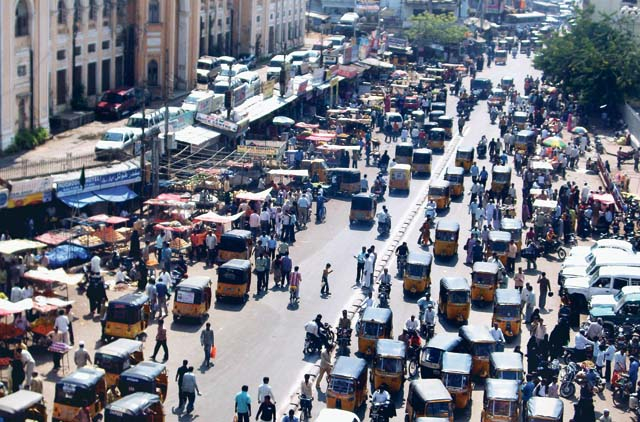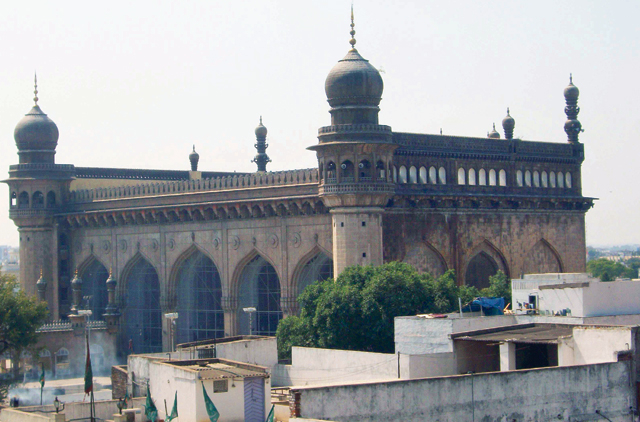
I did the best thing one could on a Sunday morning in the historical south Indian city of Hyderabad: Head to the Old City area, to a restaurant called Shadab located in the famous Madina Building.
On weekdays, the traffic madness around the area is such that you will immediately regret venturing out. On a Sunday morning, though, it is not that bad. So we ordered the traditional Hyderabadi breakfast of paya nihari (a spicy broth containing the hooves of sheep or goat) and naan (unleavened bread). Unbeatable. Follow that up with two cups of piping-hot masala tea.
Tummies full, we set out on a refresher tour of the Old City. Refresher, as I am no stranger to Hyderabad. During schooldays in the mid-1990s, the highlight of each year was the summer vacation in the city, where my cousins inhabited a haveli (traditional mansions of the subcontinent, characterised by the presence of courtyards in the centre).
Indeed, their courtyard was so big that it permitted us to play cricket in the proper manner: with stumps at both ends and a wicketkeeper behind them.
Icon of the city
First stop, the symbol of Hyderabad — the beautiful Charminar (literally "four minarets"). The scene from the top once you have made the effort to climb the steep stairs — no small feat, given the claustrophobic atmosphere — is vintage South Asia. A sea of autorickshaws, total contempt for traffic rules, screaming merchants, criss-crossing handcarts and the odd cow.
The Charminar was built in 1591 on the exact spot where Sultan Mohammad Quli Qutub Shah prayed to God to end a plague that was destroying his kingdom. The building was a response to prayers answered. Entry Rs25 (Dh2).
The same sultan started in 1617 the construction of the Makkah Masjid, located diagonally from the Charminar. The mosque, described by French explorer Jean-Baptiste Tavernier as "the grandest in all India", is an architectural masterpiece which took seven decades to complete (it was the Mogul emperor Aurangzeb who gave it the final touches). It is open for visitors throughout the day, except on Friday noon. Entry is free.
The best biryani
By now, it was four hours since breakfast and the aromas from open-air food joints were not letting us concentrate on history and culture. So we headed back to the aforementioned Shadab, this time for a plate of the Hyderabadi "dum pukht" biryani.
Most agree that Shadab serves the best version of the dish in all Hyderabad. Dum pukht means "choking the steam". I was informed that mutton is marinated in yoghurt and then cooked with basmati rice in a handi (vessel) over charcoal at a slow pace. The biryani was filling and the taste was superb. There can be no better way of spending Rs150 (Dh12).
If, like me, you love forts and castles, you must not miss the city's famous Golconda Fort, where we spent the rest of the afternoon. The fort complex is about ten kilometres in diameter.
There are panoramic views of the city from the gunners' positions, where you can still see the remains of their cannons. Built in the 17th century by the Qutub Shahi rulers, much of the fort now lies in ruins, a result of Mogul attempts to storm it.
The Moguls finally succeeded after the assault of 1687, which sounded the death knell for the Qutub Shahi kingdom and laid the foundations of the famous Nizam state of Hyderabad.
A famous man in the Nizam's administration was Mir Yusuf Ali Khan Salar Jung III or Salar Jung III (1889-1949), who was the prime minister of the seventh nizam of Hyderabad.
Mogul artefacts
One of the world's richest noblemen of his time, Salar Jung's astonishing collection of artefacts from across the world — European furniture and paintings, antiques, Mogul miniatures, etc — is displayed in the engrossing Salar Jung Museum in Hyderabad. You cannot afford to miss it. Entry fee Rs25 (Dh2); photography inside is strictly prohibited.
Our evening was spent at the famous numaish, or exhibition, that is held in the city in January each year. Merchants from all across India come here to hawk their wares.
Traditional garments, bangles, carpets — you name it. Frankly, I was bored to death until my eyes fell on the stall that advertised itself as Bade Miyan Ke Kebab (Kebabs from the Big Man). A sumptuous dinner rounded off an exciting, long day in Hyderabad.





